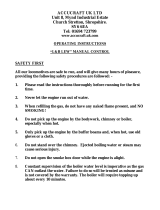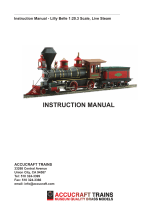
Instruction Manual
B&O 0-4-0 DOCKSIDE
Live Steam

B&O 0-4-0 DOCKSIDE LIVE STEAM
1
AML is proud to offer the famous B&O “DOCKSIDE” of the Baltimore Water-
front. Four switchers were built in 1912 by Baldwin for the B&O. Initially con-
structed as saddle tank engines, some were given tenders in later years. The
diminutive size and short wheelbase were required to handle the tight curves
of these lines.
The live steam AML models are butane gas red and are constructed with
steel frame, steel drivers, brass cab, and copper boiler. Each boiler is tted
with a water level glass and pressure gauge. The cab roof lifts up and tilts
sideways to give easy access to the cab interior.
SAFETY FIRST:
All our locomotives are safe to run, and will give many hours of pleasure,
providing the following safety procedures are followed:
1. Please read the instructions thoroughly before running for the rst
time.
2. Always do a complete rell of gas, oil and water. Never rell just the
gas to prolong the run.
3. Never let the engine run out of water.
4. When relling the gas, do not have any naked ame present, and NO
SMOKING!
5. Do not pick up the engine by the bodywork, chimney or boiler,
especially when hot.
6. Only pick up the engine by the buffer beams and, when hot,
use gloves or a cloth.
7. Do not stand over the chimney. Ejected boiling water or steam
may cause serious injury.

B&O 0-4-0 DOCKSIDE LIVE STEAM
2
GENERAL HINTS:
As with operating all machinery, whether it is a model or full size, wear will
occur. In the model steam locomotive much can be done to help prolong its life
and decrease the amount of time required in the workshop for servicing.
Keep the engine as clean as possible, and the motion free from dirt and garden
debris. The valve gear, axles and crank pins should be oiled sparingly with light
oil, e.g. “3-in-1 oil.” Over oiling attracts dirt and grit, which will increase wear.
Regularly check that screws and motion bolts are rm. Do not over-tighten, as
it will strip threads and shears bolts. When lling the lubricator, always use high
temperature superheat steam oil, suitable for locos tted with super heaters;
this is available from garden railway product retailers. FAILURE TO USE THE
CORRECT GRADE OF OIL CAN LEAD TO BLOCKED STEAM PIPES, AND
WILL INVALIDATE THE GAURANTEE.
When running your engine, avoid excessive speed and acceleration, both will
cause premature wear in the valve gear.
END OF RUN:
As previously mentioned, the locomotive will slow (due to pressure dropping)
when the re has gone out. Stop at a convenient place and open the lubricator
drain valve. Blow out all condensed water and remaining oil. Leave the drain
valve open and allow all the remaining steam to blow out. The locomotive
should be allowed to cool. When cool, clean the engine, check the motion and
oil if necessary. The locomotives should always ready for the next run (or to
be shown to an admiring friend). It is advisable to store the loco where any
residual drips of oil or water do not matter.
BLOCKED GAS JETS:
If the gas jet becomes blocked with particles of dirt within the gas, the jet will
have to be removed and cleaned. Using the spanner or pliers carefully undo
the pipe union on the gas tank. Remove the pipe and jet holder assembly from
the burner. Holding the jet holder unscrew the jet. To clear, place the jet nozzle
against the inverted gas can nozzle and clear the jet with a blast of gas. Under
no circumstances use a wire, this will damage the jet hole. Replace the jet in
the holder, ideally

B&O 0-4-0 DOCKSIDE LIVE STEAM
3
using a thread sealant sparingly on the threads. Ensure it is tightened up rmly.
Replace the assembly into the burner and re-connect the pipe to the control
valve. Ensure this is done up tightly, test CAREFULLY with a ame and the gas
“just on,” for leaks. Tightened if required.
PREPARATION FOR RUNNING:
Always service the engine in the following order; gas, oil then water.
To ll the gas tank: invert the gas can and apply the nipple to the gas inlet valve
on the top of the turret in the tender. You will know when the gas tank is full; gas
will blow back from the inlet valve in a strong jet. A small amount of gas and air
will escape during lling, but the difference between this and when the tank is
full is always clear. Always keep the gas can valve vertical when lling the gas
tank. After lling, pour room temp water into tender for fuel tank water bath.
To ll the lubricator: as you will read in the instructions for the “end of the run”,
the lubricator should be empty of oil and water with the valve left in the open
position. Now close the valve and remove the ller cap. Fill-up the lubricator
with steam oil to about ¼ inch below the top. Leave the ller cap off for the
present, so that any trapped air can escape. Remember to ret the cap after
you have lled the boiler.
To ll the boiler: remove the ller cap. Fill the boiler completely- ideally using
distilled water, using the large syringe provided. When the boiler is full of water,
pull out 30 ml of water using the large syringe. This will allow space in the top of
the boiler for steam to build. Replace the boiler ller cap. (Filler caps should be
rm nger tight). They are sealed with a trapped “O” ring and, therefore should
not be over-tightened.

B&O 0-4-0 DOCKSIDE LIVE STEAM
4
LIGHTING UP:
Open the smoke box door; just pull it open by the door handle. Light your
lighter/match etc., and gently open the gas control valve until a gentle hiss is
heard in the burner. Apply your light into the smoke box and the ame should
‘pop’ down the re tube and ignite the burner inside the re tube. If the gas
valve is not opened enough the ame will not “pop back”; it will either fail to
ignite or there will be a ball of ame around the front of the engine, which will
then blow the whole re out (after giving the driver a fright)! When the re
sound has stabilized after about 30 seconds the gas can be turned up until
a healthy roar is heard. The smoke box door may be shut after about two
minutes. Now leave the locomotive to raise steam.
RUNNING:
When the engine has raised to about 40 psi, you are now ready to start running.
It is advisable to run the engine in reverse rst. It clears the condensed water
from the cylinders best this way. Before commencing your rst run of the day,
it is advisable to put a cloth loosely over the chimney for a few minutes, as
condensed water will be ejected from the chimney. This is quite normal; the
motion of the engine will be jerky until all the condensate has been ejected.
DO NOT stand over the chimney as ejected boiling water/steam
can cause serious scalding.
Place the direction lever into the reverse position, and then open the main
steam valve. The engine should start to move off in reverse direction. When
starting from cold it will be jerky, this is normal as it has to clear the condensate
from the system. The more the main steam valve is opened, the faster the
engine will go; it is recommended to start slowly and learn the road with your
engine.

B&O 0-4-0 DOCKSIDE LIVE STEAM
5
After a minute or so, remove the cloth and continue running. In running it is
correct practice to balance the boiler pressure against the load being pulled
and track conditions. With a light load and level track the pressure may need to
be only 25-30 p.s.i. Therefore, turn the gas control down to keep this pressure.
When running a heavy train with steep gradients, increase the pressure by
turning up the gas. The ideal running pressure can be learned by experience
and is one of the pleasures of running a live steam engine. There is no need
to have the safety valve constantly blowing off (it is what its name implies – a
safety vent for excess steam pressure). In all our designs, the gas has been
programmed to run out just before the water, thus it is important not to rell the
gas alone in order to lengthen the run by a few minutes. When the gas runs
out a complete gas, oil and water service must be done (remember GOW, also
remember to shut the gas regulator before relling and DO NOT rell with gas
near any other live steam loco or open ame). When locomotive slows as the
pressure falls at the end of a run, stop the engine. Gently open the lubricator
valve and blow out any condensed water. If you intend to continue running,
close the drain when you see oil coming out of it and carry out a general rell.
If it is the last run of the day, leave the lubricator drain valve open and blow the
lubricator completely clean.
POSITITON OF FILLERS AND DRAINS, ETC.:
The gas tank is in the cab, the gas-lling valve is on the top of the gas tank
turret.
The gas control valve is attached to this turret.
The lubricator drain is directly beneath the lubricator. To drain, un-screw the
drain valve turn about ½ a turn.
The boiler water ller is on top of the steam turret on the boiler in the middle
of the cab. Undo the knurled cap to ll water. The main steam regulator valve
is the wheel valve on the rear of the boiler-lling turret.
The direction control is the lever in the right side of cab. To operate, pull gently
outwards and move to the desired direction. The control is “gated,” and will
therefore hold itself in the full forward or reverse position.

B&O 0-4-0 DOCKSIDE LIVE STEAM
6
Technical Specications
Feature: Butane fuel, Single ue gas red copper boiler.
Safety valve, Throttle, Pressure gauge, Piston
valve with reversing valve.
Scale: 1:29 Scale, 45 mm Gauge
Minimum Radius: 30.11 inch (76.5 mm)
Locomotive Information:
Length: 13.35” inches (339.06 mm)
Width: 4.13” inches (105 mm)
Height: 5.87” inches (149 mm)
Caution!
This model is an accurate replica of the original locomotive.
It has sharp and moving parts. The locomotive drive rods
are stainless steel with sharp edges.
AT ANY TIME, OPERATORS MUST NOT BECOME IN
CONTACT WITH THE MODEL WHILE IT IS POWERED.
UNDER NO CIRCUMSTANCES SHALL ACCUCRAFT
TRAINS BE RESPONSIBLE FOR ANY INCIDENTAL OR
CONSEQUENTIAL DAMAGES ARISING IN REGARD TO
ANY ACCUCRAFT PRODUCT.

33268 Central Avenue
Union City, CA 94587
Tel: 510-324-3399
Fax: 510-324-3366
Email: [email protected]
Copyright 2010
/








